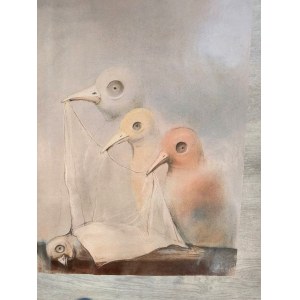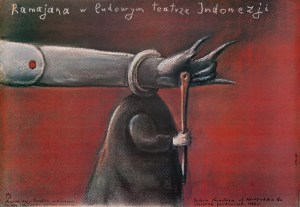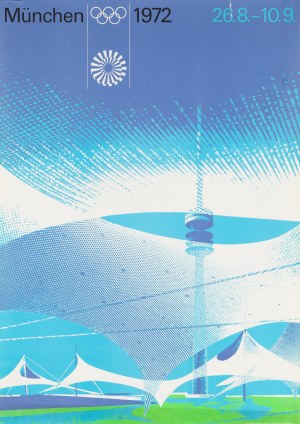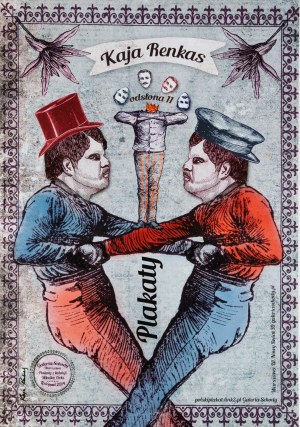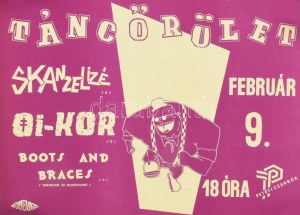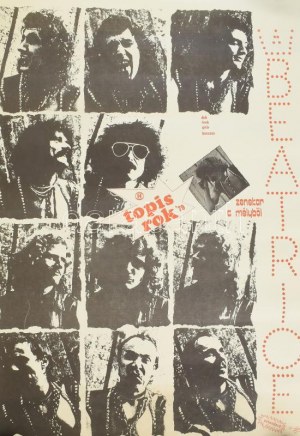Poster by Stasys, dimensions:83x65 cm.
Stasys Eidrigevicius:
Painter, poster artist, creator of ex-librises, drawings, book illustrations, happenings, installations.
He was born on July 24, 1949 in the village of Medinishki in Lithuania to a Polish father and Lithuanian mother. In 1964-68 he attended the School of Arts and Crafts in Kaunas, where he studied artistic design of leather products. He received a diploma with honors for book covers made of leather. He began his artistic studies at the faculty of painting and graphic design in 1968 at the Institute of Fine Arts in Vilnius (graduated in 1973). Since 1980, he has lived in Warsaw.
The artist has won many awards at international exhibitions and competitions, including the International Biennial of Contemporary Exlibris in Malbork (1973, 1975), Interexlibris in Frederikshavn (1979-82), the International Exhibition of Illustrations for Children in Bratislava (1979, 1981), the 9th "Premio Europeo" Competition (1982), the 9th International Poster Biennial in Warsaw (1984). In 1981, the book King of Ravens, illustrated by him, received the award of the Polish Society of Book Publishers as the most beautiful book of the year. For his illustrations for children, the artist received the Prime Minister's Award in 1984, and in 1986 the Grand Prix at the International Competition for Children's Book Illustration in Barcelona. In 1988 the artist was awarded the American Film Critics Award for his poster for Janusz Kijowski's film Masquerade, and in Warsaw he received the Cyprian K. Norwid Award. In 1994, the weekly magazine Polityka awarded the artist a "Passport" for lifetime achievement. In 1999, Stasys was awarded the Gold Medal at the Polish Poster Biennale in Katowice. In 2000 the artist was awarded the Lithuanian Order of Gediminas, and in 2001 the Lithuanian National Prize in Art.
Stasys Eidrigevicius' works are in the collections of the National Museums in Warsaw, Wroclaw, Poznan and Szczecin, the Poster Museum in Wilanow, the British Museum in London, the Museum of Modern Art in New York, the National Library in Washington, Creation Gallery in Tokyo, the Vatican Museum in Rome and private collections around the world.
In 1994, a film was made by Andrzej Papuzinski entitled Seven Mysteries According to Stasys (Stone, Pendulum, Desire, Hunger, Labyrinth, Hope, Liberation). In 2009 there was the premiere of the film Buzkaszi by French director Jacques Debs, starring Stasys as the painter.
The work of Stasys Eidrigevicius represents a unique unity, despite the artist's use of different techniques of representation. Symbolic images of being play an important role in the evocative vision of his world. The art derives in a straight line from symbolism and surrealism, but creates a unique, separate and coherent world derived from the artist's imagination, which has lived to be described as "serene with wise sadness." It is populated by big-eyed, lonely and fearful children, as well as birds, domesticated animals, animated objects, and masks placed in nostalgic childhood landscapes. It is full of metaphors, obsessively recurring motifs, and above all there is an unusual mood, full of deep reflection. Eidrigevicius creates a plastic world by building it from images inspired by poetic associations and subconsciousness, but consisting of realities extracted from the storehouse of memory and keen observation based on intuition and feeling.
"I observe carefully the people around me. I look at their faces, figures, movements. From these crumbs of reality I constantly create my own theater of gestures and silhouettes," the artist explained in an interview.
He presents this theater to us through his characters, who take the forms of puppets with big eyes and potato noses, roadside scares, birds with wooden wings or flying people. The artist builds poetic situations for them, piled up in fairy-tale logic, although his art refers to human experience, emotions and morality.
Stasys began with exlibrises, small graphic forms (etching, aquatint) and painting (gouache, pastel). While still in college, he exhibited realistic paintings and graphic exlibrises, in which he achieved incredible mastery. He was often awarded for his mastery of metal techniques; in 1973, when he was still a student at the Vilnius Institute of Fine Arts, he took part in the Exlibris Biennale in Malbork, where he received a medal of honor. It was in these graphic miniatures that Eidrigevicius began to depict his private world remembered from his childhood and told in fairy-tale, nostalgic tones. Later, already during his stay in Poland, there were illustrations for books, especially for children, which brought him international recognition. The artist began making his first illustrations while still in Lithuania, but there he met with interference from the censors. For the book Robot and Moths, written by the well-known Lithuanian writer Vytauta Zilinskaite, Eidrigevicius made illustrations depicting bald children. This aroused a protest from the publisher and the artist had to add beautiful curly blond hair to them. Such incidents influenced Stasys' decision to move to Poland. The artist brought his own melancholy imagination and metaphors to the world of children's literature. He usually treats his illustrations as small paintings dedicated to children. His works are quite distant from the content he illustrates, they are like a separate story, and perhaps that is where their value and difference lies. Eidrigevicius' illustrations found their way into elite publications devoted to book graphics in Japan, as well as the prestigious Swiss magazine Graphis, which put his work on the cover. He was also soon included in a list of the world's 110 most outstanding illustrators, which was announced in Japan. An important area of his work is drawing, brought to perfection by the artist in both intimate and monumental forms. Stasys also makes posters, primarily using the pastel technique, for which he has won numerous awards. The language of his posters is derived from drawing, and is economical but powerful. It derives from a painterly and metaphorical spirit, strongly marked by the artist's individualism. An exhibition of Stasys' posters in Tokyo in 1989 aroused the interest of one of Japan's most prominent graphic designers, Yusaku Kamekura, and resulted in a presentation in an edition of the luxury magazine Creation devoted to the achievements of contemporary graphic design."
-Source: Culture.pl



